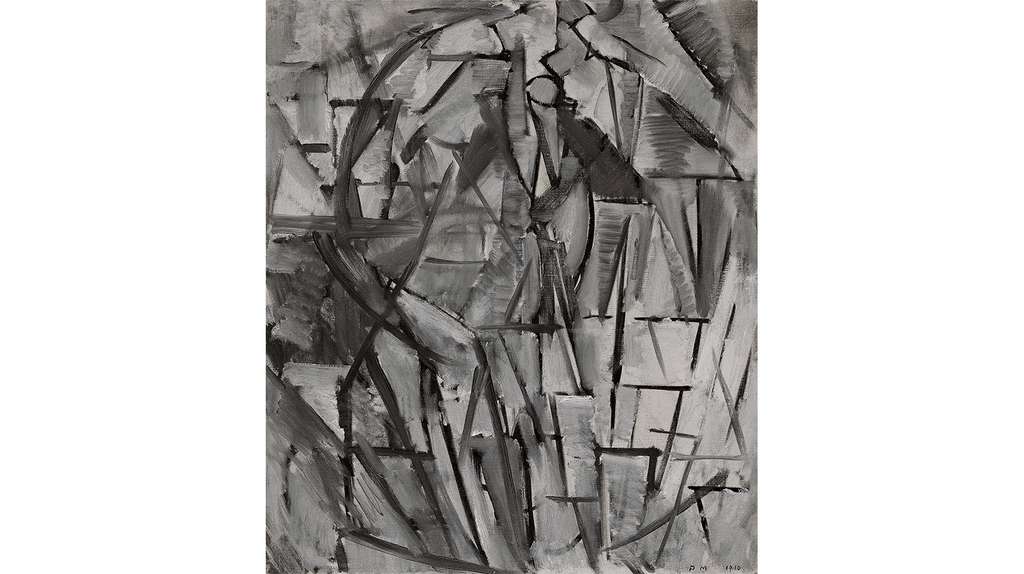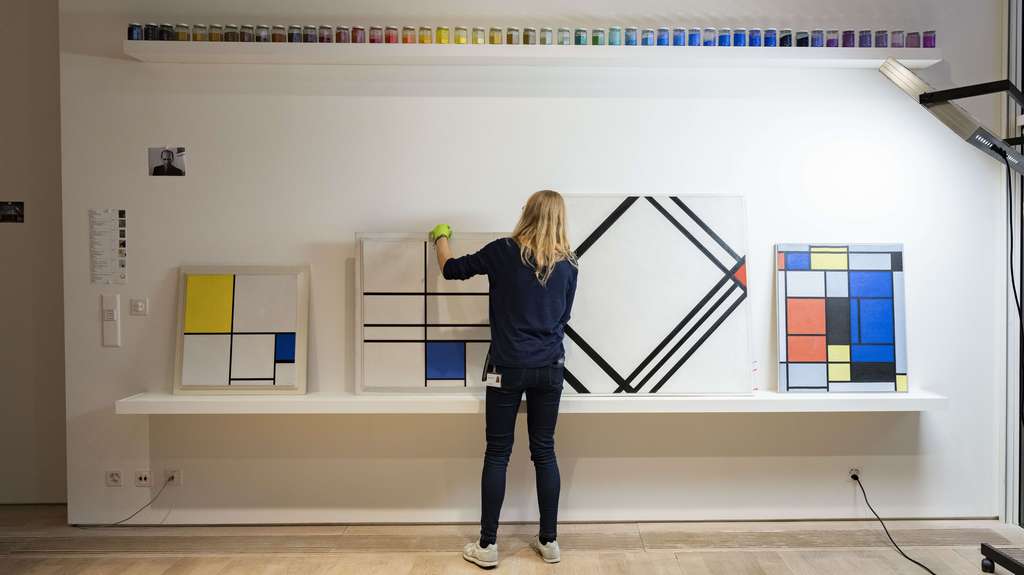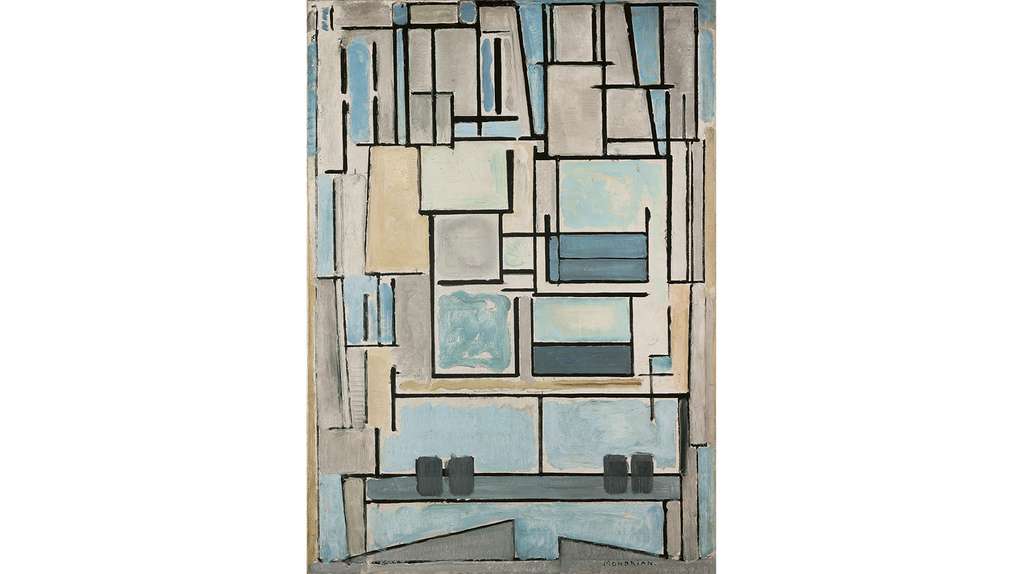Piet Mondrian, Composition No. XVI
In Mondrian’s Cubist phase, from 1911 on, the motif of the tree has a prominent position.
Composition No. XVI also belongs to the group of paintings addressing this theme, and was probably created on the basis of tree drawings made by the artist at the end of December 1911, which he brought with him when he moved from the Netherlands to Paris. The composition shows typical features of Cubism, with the fragmenting of the contours and the dissolution of traditional perspective. However, the oval shape of the motif endows the painting with a particular sense of closure. With the horizontal emphasis through thicker black lines in the area of the branches, Mondrian established a focal point just below the center of the canvas, from which the picture takes its particular presence and radiance.
Despite the geometric structure of Composition No. XVI, the generally fine lines and sketch-like application of color make the picture light and transparent. The latter effect is amplified by the fact that large areas of the primed canvas remain visible. For this work, moreover, Mondrian chose light pastel tones that are unusual in his Cubist pictures. The choice of colors and the quick brushwork could suggest that he was engaging here with the art of Cézanne, whose paintings he had seen on various occasions in 1911.
Images of the painting captured with various technical imaging techniques provide various information: visible light, raking light, transmitted light, UV fluorescent light, IR reflected light, IR transmitted light, X-ray.
Original traces of the artist’s hand
An “authentic” work of art, in the terminology of conservation, is one that has aged naturally and remains untouched by restorers. The condition of Composition No. XVI is a remarkable stroke of luck. The picture, painted over a century ago, is astonishingly pristine. This is apparent, above all, in the many distinct traces of the artist’s hand, but also because the work was never treated or modified in the past.
Composition No. XVI has been dated to the summer of 1912. The main stages of its life, with its exhibition history and several changes of ownership, are documented in the museum archive. However, archives rarely tell the full story. Information is generally lacking about circumstances that may have led to changes in the picture’s state of preservation: for example, whether it was treated with due care, protected against damage from sunlight, or properly handled and crated for shipping. Since the materials of a painting—mainly the stretcher, the ground and paint layer—are often fragile and subject to changes over time, information about these aspects is especially relevant in assessing the work’s conservation status.
This is where our research begins. Through intensive examination and scientific analyses of the painting, we collate observations and findings, like pieces of a jigsaw puzzle, to draw conclusions about authenticity.
Our own research benefited greatly from recent insights regarding Composition No. XVI in connection with an exhibition, Mondrian and Cubism, Paris 1912–1914, that took place in 2014 at the Gemeentemuseum Den Haag (February 25—May 11, 2014). This project included a historical reconstruction and documentation of an exhibition organized in 1914 by the Walrecht gallery in The Hague, featuring sixteen pictures, among them Composition No. XVI.
Examples of important indicators
Original strainer
Piet Mondrian chose a strainer of a type he used very often, in which the inner edges of the bars are slightly tapered towards the canvas at the front and back of the picture. This serves to protect the canvas, preventing the frame from marking the fabric.
Authentic traces of the artist’s hand
Past methods of restoration often change a work’s material identity, for example, by replacing stretchers and restoring whole sections of the canvas and the paint surface. In Composition No. XVI the painting is completely untouched, as can be seen from an image with reflected light, clearly showing the original matt and gloss values of the colors. The stretcher construction and the stretching of the canvas are original, too, since there are no new tacking holes in the canvas margins. The folding of the canvas at the corners of the strainer is also characteristic, as is the manner of cutting the canvas, exactly parallel to the stretcher at the back of the picture.
Traces from the studio
The verso of the painting reads like an open book. Mondrian noted down various titles for works, with numberings, on the back of the canvas and the stretcher bars. The titles were part of a chronological labelling system used when submitting works for exhibition, and were never considered definitive.
- The names refer to the type of work in question, for example “Tableau” or “Composition.”
- The numbers can be Arabic or Roman, with letters in capitals or lowercase.
The verso of the strainer bars offers further clues. Remains of torn and glued paper indicate that Mondrian previously used the frame for stretching paper when working on prints. Tacking holes at the corners of the stretcher point to the same previous use.
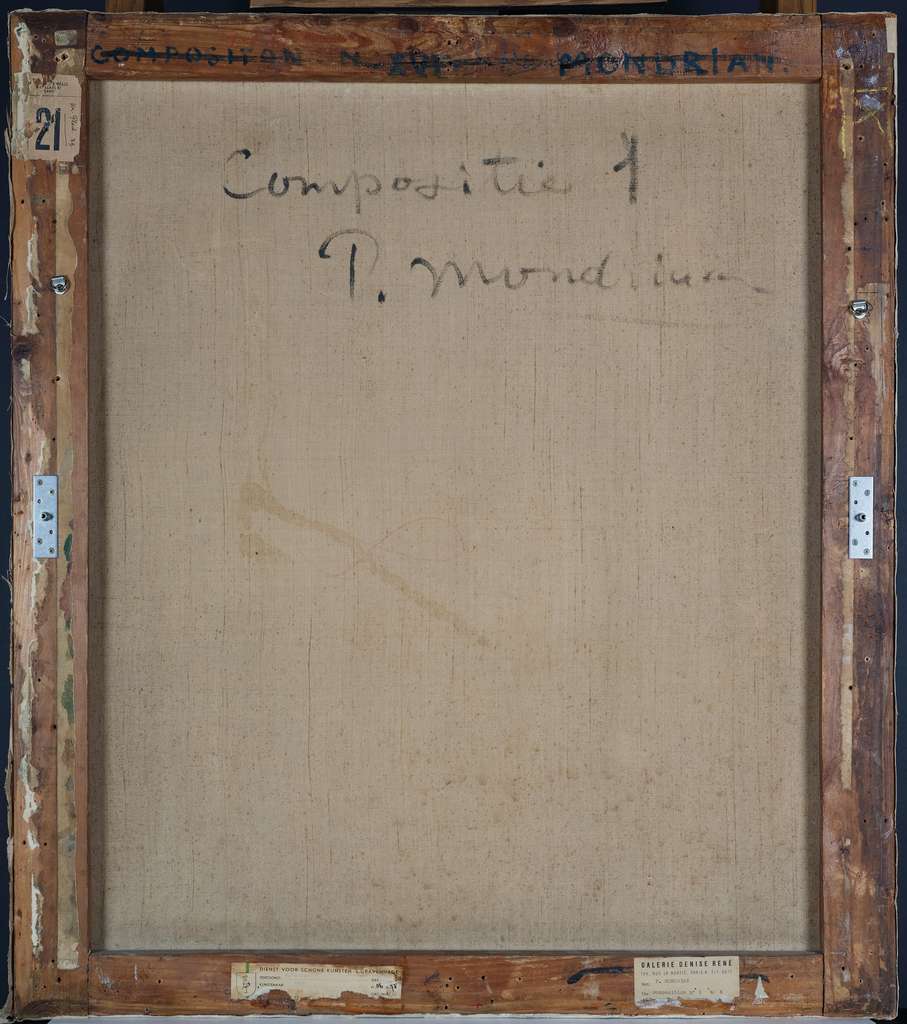
Backside
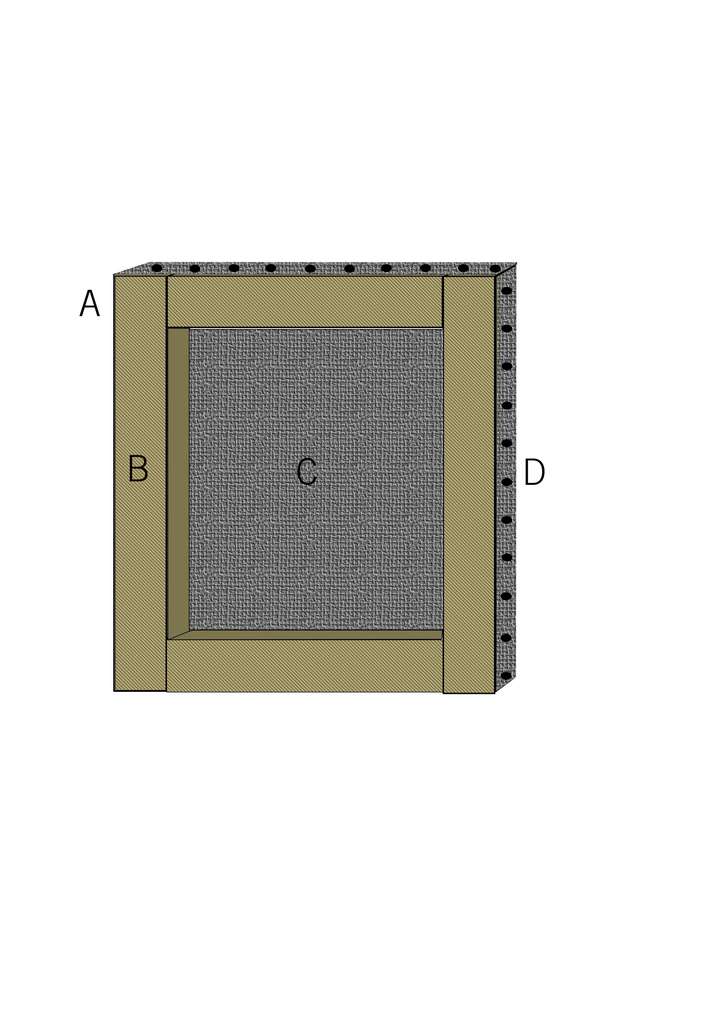
a. reverse
b. strainer
c. canvas
d. tacking margin
Technical analysis, a key area of conservation research
Technical analysis involves the exact identification of components that are key to understanding the materials used in the works concerned, which also facilitate comparisons within an artist’s oeuvre. Analysis also makes it possible to diagnose changes due to ageing, as a basis for exact prognosis regarding the work’s long-term preservation.
The analytical research of materials and techniques under the Piet Mondrian Conservation Project is supported by a team of acknowledged experts at the Cultural Heritage Laboratory in Amsterdam. Analyses are being carried out on the main materials—such as canvas, pigments, and binders—in seven paintings. This is done with non-invasive methods. In a few selected cases only, microsamples (less than 0.5 mm) from the original are examined.
The analyses also help to interpret specific questions arising from the general research.
Canvas analysis
In the examination of the painting Composition No. XVI the vertical (warp) threads of the canvas were found to show greater evidence of browning than in other works, which suggests that a lower-quality blended fabric was used. However, analysis has confirmed that the fiber for both threads was linen, a classic artist’s material with good stability and durability.
Analysis of the ground layer
For Composition No. XVI, Piet Mondrian used a pre-primed industrial canvas, as was customary at the time. The readily visible ground layer is cream-colored. The examination of further paintings from this period has shown that the ground is of similar color; in the past, however, the cream tone was often thought to have resulted from discoloring due to ageing. Cross-section images (see description) show that the ground is comprised of two layers with a proportion of dark, yellow pigments that create the specific tone, as a color nuance intended by the canvas maker and deliberately chosen by the artist.
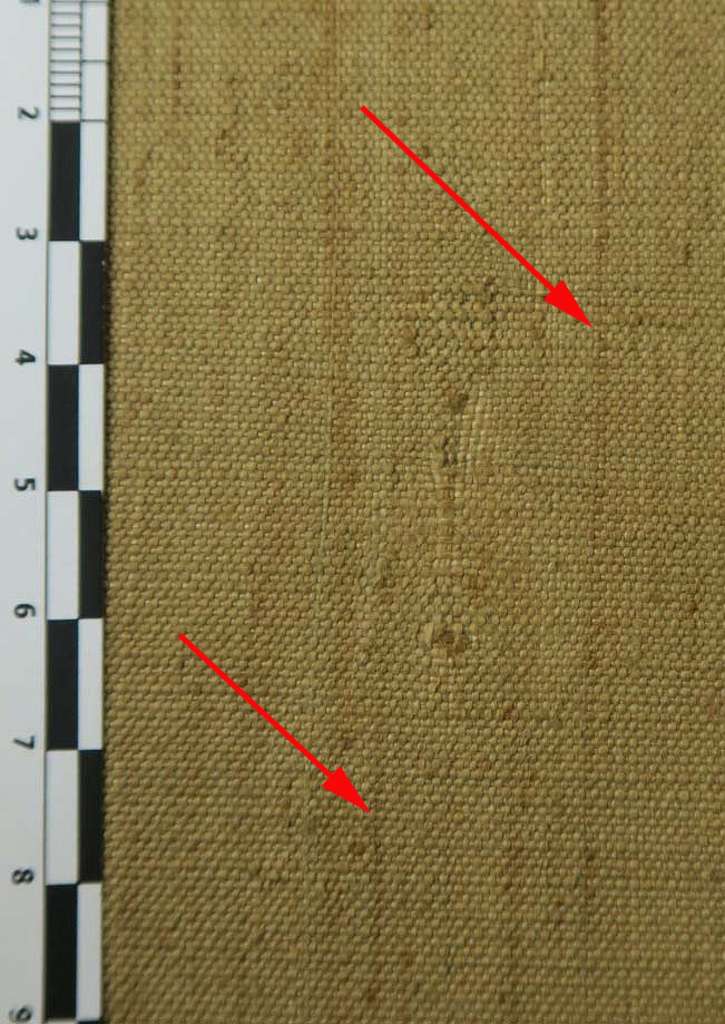
Detail canvas: strongly browned warp threads
Terminology for a microscopically small material sample which is ground and polished on a surface for a microstructural examination. In this way, the individual layers of paint can be detected, similar to a sliced cake.
Pigment analysis:
Piet Mondrian structured the composition of his painting like a grid or scaffold, painted with a brush using thinned black oil paint. The remaining areas between the lines were then painted in a palette of white, gray, ocher, green, and pinkish violet: colors that for Mondrian were relatively unusual. The execution is spontaneous, with a sketch-like quality, applying the color “wet on wet,” with areas of impasto. The aim in analyzing this picture was to determine the colors used by Mondrian and ascertain how to interpret them in the context of other paintings.
An unusual feature in this phase of Mondrian’s oeuvre is the use of violet. Analysis of this yields surprising results: the red in the color contains a low concentration of hematite, a traditional pigment. The violet or pink tone is created by the admixture of a lead white pigment. The other color materials are also classic artist’s colors:
The green is chrome green. The yellowish tones come from ocher pigments. The seemingly light-blue color is a mixture of lead white and carbon black, the latter of which is also used for the black lines. All the colors are classic oil paints, generally mixed, in the case of Composition No. XVI with white lead.
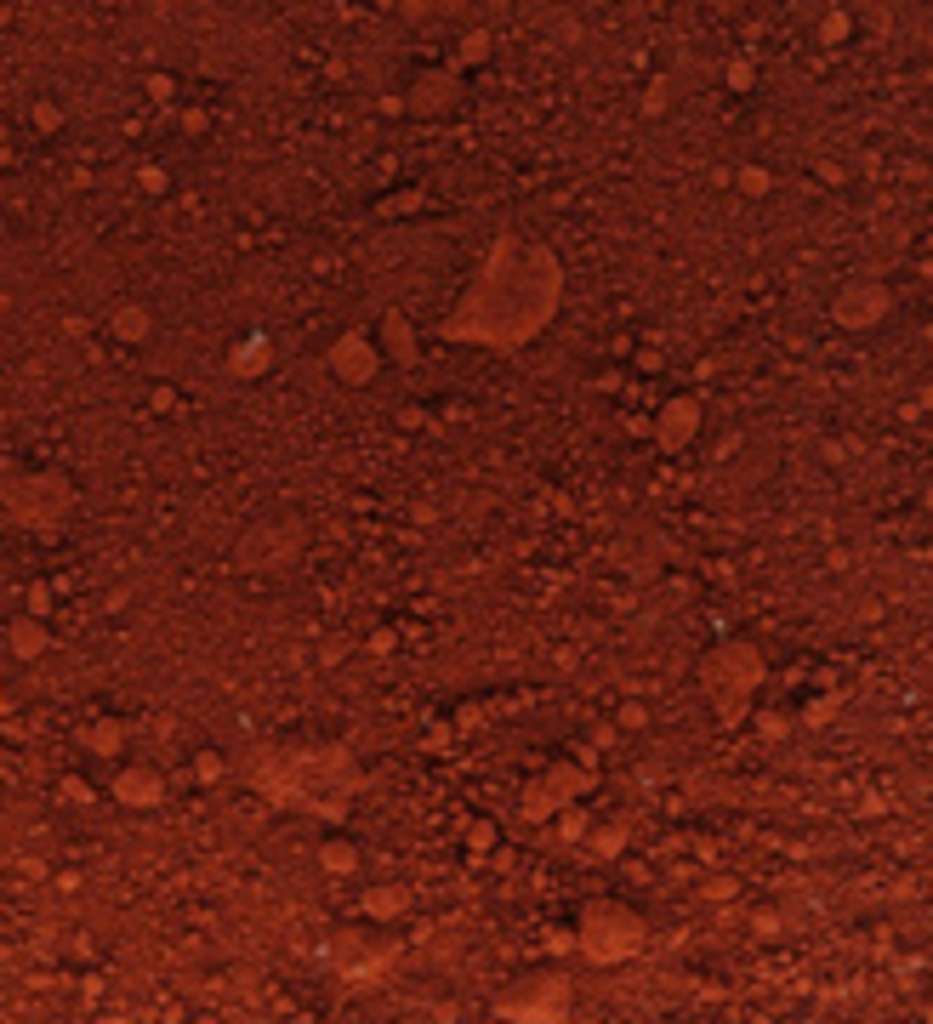
Hematite: The natural iron oxide pigment has excellent coloring properties
Explore more works
Eukalyptus
Eucalyptus provides a striking demonstration of Mondrian’s experiments with stylistic elements of Cubism in the treatment of composition and color.
Return to overview
Get an overview of the Piet Mondrian Conservation Project and the seven works being examined.
Composition No. VI
(Compositie 9, Blue Façade)
In Composition No. VI Piet Mondrian is more interested in the structural characteristics and colors of the house as sources of inspiration than in its figurative representation.
